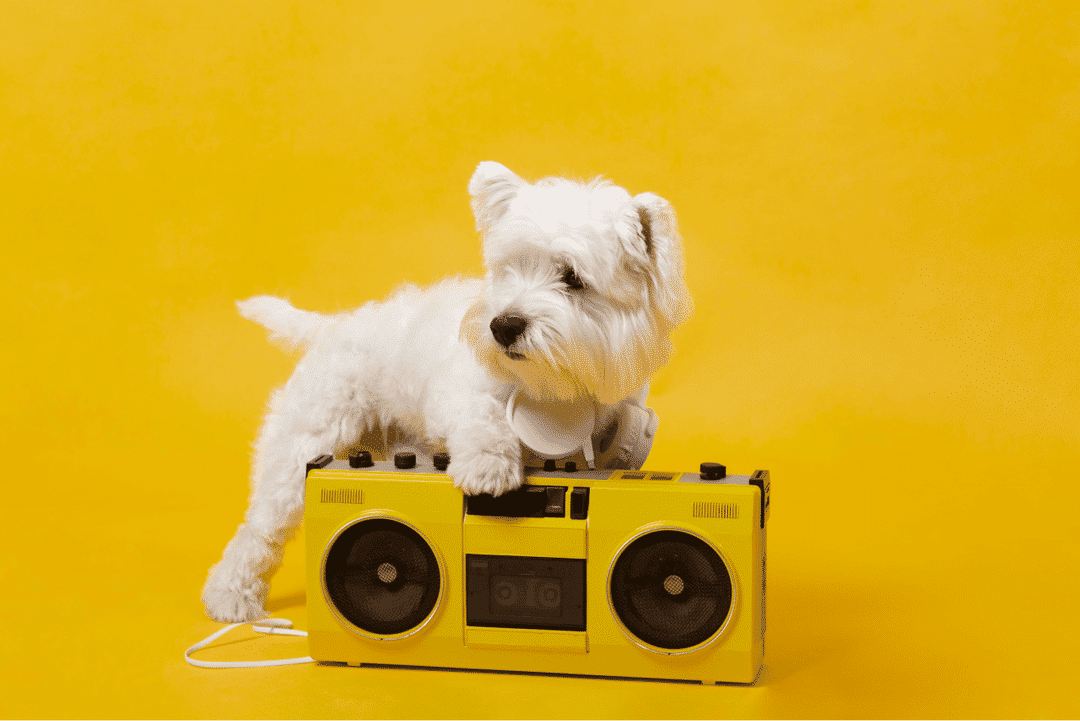
Training
How to train a puppy to be calm: introducing every sound
• 4 min read
Are you looking for the best pawrenting tips for your puppy?
In this blog we will discuss:
- Your puppy’s sensitive period and habituation process you should be aware of.
- How to provide new sound experiences to your puppy.
- List of sounds you need to provide.
New to known
From New: Sensitive period
There is a sensitive period early in the dog’s life where experience has the most influence. This early sensitive period is between 3 and 12 weeks of age. Owners need to understand the importance of every daily interaction that their puppy experiences for later behavior.
Even if your dog passed this critical period, it is important to continue the socialization.
To Known: Habituation
Habituation is defined as ‘learning not to respond to a stimulus’ or ‘learning to accept as a normal part of their environment all the day-to-day objects, sounds and other items that they may encounter.
Ideally, a puppy should be habituated to all the stimuli, animate and inanimate, that they are likely to come across later in life.
How to provide new sound experiences
Remember low and slow, short and sweet. Start with love volume, slowly increasing by short sessions and pair with your puppy’s favorite treats or activities.
# 1 Find the new sound
- Spend time sitting on the patio, have some snuggle time and just listen to the world around - sounds may include people’s voices, freeway sounds with trucks and cars, and a plane passing overhead.
- Make a note of the sound that your puppy over-reacted to, and then make a plan on training sessions to that sound in a controlled way.
# 2 Turn on the new sound while eating
- Evaluate your puppy’s body language
Did your puppy notice the sound but go right back to eating?
Or did your puppy stop eating and exhibit stressed body language?
- Signs your puppy might be stressed by the sound
If your puppy begins to bark, skitters away or even tries to hide the puppy is likely under stress. Other signs include ears back against the head, tail tucked, eyes widened, licking the lips or yawning, and lifting a front paw with or without shaking the body.
# 2-1 Adjust volume accordingly
- If the puppy startled to the sound and stopped eating, turn the sound off and try again later with higher value treats or toys.
# 2-2 Continue or increase volume
- If the puppy noticed the sound but went right back to eating, continue playing the noise as its current volume or consider slightly increasing the volume.
- As your puppy finishes up the meal, turn off the sound. One sound socialization session is completed!
# 3 Real-Time Sound in Real-World
- If the sound was sudden and your puppy reacted, toss some high value treats right away. This can build the association that a sudden noise predicts favorite treats raining from the sky.
- Be aware of your reaction as your puppy looks to you for cues on how to react to sudden environmental changes - stay calm and say “It’s okay!” in a calm, happy voice when your puppy becomes nervous.
- If the sound is sustained, turn it off or move to an area that’s less loud.

List of the sounds
Ensuring exposure to a range of sounds, particularly household sounds, but also vehicle noises and similar is important. Focus first on the sounds that are prevalent in your home environment.
Here you can find the soundtrack: https://open.spotify.com/track/7tWgPvtmnfAuPpbFaBmTK4
⛈️ Rain sounds
- Large thunderstorm with light rain
- Heavy rolling thunder with steady rain
🎇 Fireworks and gunshots
- Mortars launching fireworks with multiple explosions
- Intense fireworks with distant faint applause
- Pump action shotgun firing
- Heavy shotgun blasts
⏰ Loud alarm sounds
- Fast pulsing burglar alarm
- Car alarm
- Wailing ambulance siren
- Police car siren
- Constant car horn blasts
- Large alarm clock bell ringing
- Electronic alarm clock beep and smash
☎️ Bell ringings
- Musical doorbell chimes
- Electric doorbell ringings
- Telephone bell ringings
🛩️ Traffic sounds
- Jet plane passing overhead
- Helicopter passing overhead
- Car starts, idles and pulls away at fast speed
- Motorcycle starts, engine revs and stops
😮 Human noises
- Human baby crying
- Large party crowd of young adults
- Human female cough, sneeze
- Human male cough, sneeze
- Residential construction site sounds
- Hammer drill into concretes
🏠 Household noises
- Microwave oven starts, runs and stops with end beep
- Household blender starts, runs for a long time and stops
- Vacuum cleaner
- Electric jackhammer cutting through wood
- Beer bottles clinking together
- General dish noise and clatter at a dinner table
- Crystal glasses clinking together in a toast
- Dinner dishes dropping
- Drinking glass smashes into pieces
🐕 Animal sounds
- Large group of dogs barking and howling
- Viciously barking large dog
- Bloodhound dog barking
- Siberian husky dog barking
- Interior sound of a large dog kennel
- Domestic cat meowing
- Small kitten meowing
- Angry and hungry cat meowing
- Backyard suburban sounds with various birds
- Summer forest sounds with various birds
Closing
Helping your puppy acclimate to different sounds goes a long way in helping the dog feel comfortable, less stressed when there’s a sudden noise, and prevent unwanted behaviors such as alert barking.
MMDC Team
Healthy Pet, Happy Pawrents 💛